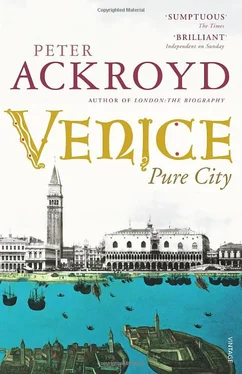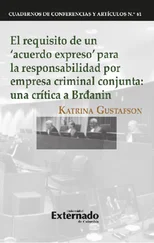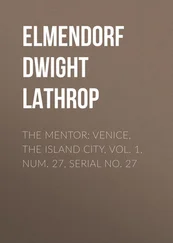The “wicked wind” may come from several points. An east wind blows in from the sea, refreshing in the warmer months but crueller in the colder seasons of the year. A wind from the north-east, the bora , brings the colder air from the northern region of the Adriatic. A humid wind comes from the lagoon, known as the salso because of its saltladen content. Some people say that it smells of the algae and seaweed of the surrounding waters. The salt and damp penetrate the houses of Venice; the paint flakes, and patches of plaster fall from the walls. The bricks crack and eventually crumble.
There are gusts of wind that pass very quickly, and eddies or squalls of circulating air. Sir Henry Wotton wrote of “flashing winds.” All this is of the nature of the sea. There is a south-westerly wind, too, once called garbin . It may be of this wind that Saint Bernardino of Siena wrote in 1427. He asked a correspondent, “Were you ever at Venice? Sometimes of an evening, there comes a little wind which goes over the face of the waves and makes a sound upon them, and this is called the voice of the waters. But what it signifies is the grace of God, and the breath breathed forth by Him.” Even the weather of Venice was once deemed sacred.
But the most celebrated wind is the scirocco , the warm wind that comes from the south-east and can persist for three or four days. There is a scirocco di levante and a scirocco di ponente , a hot scirocco and a cool scirocco; there is even an elusive wind called the scirocchetto . The scirocco itself has been blamed for the Venetian tendency towards sensuality and indolence; it has been accused of instilling passivity and even effeminacy within the citizens. Why should people not be moulded as much by climate as by history and tradition? The outer weather can make or unmake inner weather.
Yet some weeks of the winter can be harsh, a potent reminder of the Alps and the northern snows. The most frequent weather lament concerned the bitter cold. In the winter of 1607–08 those who went fowling in the lagoon were on occasions frozen to death, and there were reports of travellers being surrounded and killed by packs of starving wolves. At the beginning of the eighteenth century came a famous “Year of the Ice” in which provisions were brought to the frozen city by sledge. In other winters the lagoon also froze, and the Venetians could walk over to the mainland. In 1788 great bonfires were lit on the Bacino, the basin of water in front of the piazzetta; stalls and booths were erected on the ice, in the Venetian equivalent of a Frost Fair. In 1863 great sheets of ice went up and down the Grand Canal, flowing with the tide, for a month. Venice was then truly the frozen world, the ice covering the houses and palaces as well as the water. The light was blinding. Venetian houses were not built for the cold; the great windows and the stone floors of the larger dwellings made them almost intolerable during the blizzards of winter. Yet there is still something inexpressibly delightful about Venice in the snow, the whiteness creating an enchanted kingdom where what is fluid has become crystal; the quiet city then becomes wholly silent beneath the panoply of snow.
But there are winter weeks of not quite snow and not quite rain. These may become the weeks or days of fog. The iridescent mist or haze is then enveloped by the myriad fogs that creep in from the sea. The grey Istrian stone becomes an outpost of the fog, a sentinel of consolidated fog looming out of the gloom. As the Esquimaux have many words for ice, so the Venetians have many names for the fog— nebbia, nebbietta, foschia, caligo . In the midst of the nebbia , it is as if heavy rain-clouds had come to rest upon the earth and water. Nothing can be seen or heard. The fog sometimes shrouds the city so that the only sounds are those of bells and muffled footsteps; if you take the vaporetto , or water-bus, that goes around the city you disappear within the white curtain about fifty yards (about 45 m) from the shore; all that is visible of Venice are the posts carrying lights. The city only rises before you when you arrive at the next stage.
There are portents for flood. The air becomes heavy and still; the roar of the sea can be heard breaking against the Lido. The waters in the canals stir uneasily, and become more green with the influx of the sea. The tide is driven forward by the wind. The water rises to the edge of the fondamenta but then, more alarmingly, it begins to well up beneath the city itself. It spouts up through the storm drains and between the paving stones; it seeps through the foundations, rising higher and higher; it washes against the marble steps of the churches. The city is at the mercy of waves that seem to be of its own making. When the sirens sound, Venice prepares for another acqua alta .
This high water, flooding the fondamenta and the campi , making a lake of Saint Mark’s Square, invading houses and hotels, is not unusual in the city. One chronicler gave an account of a great flood in 589, although assuredly there were many before that date. They may have been so common that they deserved little notice. Other floods are recorded in 782 and in 885, when water invaded the entire city. They have been occurring ever since. In 1250 the water rose steadily for four hours and, in the testimony of a contemporary, “many were drowned in their houses or died of the cold.” It was believed that the floods were provoked by demons and bad spirits, while the only protection lay in invocations to the saints who guarded Venice. At a later date there was less recourse to supernatural help. In 1732 the area of the piazzetta, facing the lagoon, was raised by one foot (0.3 m) on a calculation that the sea at Venice rose three inches (76 mm) in every century. This was an underestimate.
The acqua alta is part of a natural cycle, occurring when wind and tide and current converge in what is for Venice a fatal embrace; the bora and the scirocco can both cause surges of storm in the sea. There is also the phenomenon of the seiche , an oscillation or standing wave in the relatively shallow waters of the Adriatic. But if Venice is sinking, it is in some measure due to the removal of water by industry from artesian wells. When the water was taken from the silt and the clay, the water table was lowered—and, with it, Venice. The deepening of waterways within the lagoon, and the reclamation of marsh-land, have also increased the danger of flooding.
There are several inundations in every century, therefore, but in recent years they have been increasing in size and frequency. In the 1920s there were 385; in the 1990s there were 2,464. In November 1966, the flood reached a height of six feet four and a half inches (1.94 m). The scirocco blew for two days, keeping the murky and polluted water locked within the lagoon. At the time some believed that it would mean the death of Venice.
When the rain came, it was collected within the stone gutters of the churches and houses; it ran through the pipes and then through conduits until it reached the underground cisterns beneath every campo . There the water filtered through a body of sand before penetrating the well shaft. It was fresh and pure. The wells, or pozzi , were ubiquitous. At the middle of the nineteenth century there were still 6,782 remaining in the city, Byzantine or Gothic in construction. An immense well was sunk in the fifteenth century, in the middle of Saint Mark’s Square. Two great public cisterns were built in the courtyard of the ducal palace, from where the water-carriers or bigolanti would carry their precious commodity. They were the peasant women of the Friuli, who wore bright skirts, white stockings and hats of straw or felt; they wandered barefoot through Venice, with their copper buckets, calling out “acqua—acqua fresca.” It was a mournful, as well as a melodious, cry.
Читать дальше












